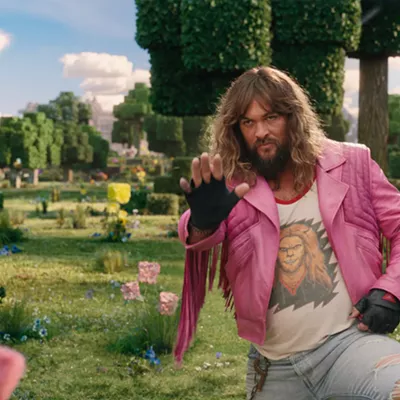The old Lakota man known simply as Dan lives in a modest two-room house on the Pine Ridge Indian Reservation in South Dakota, miles away from civilization. He has no indoor plumbing, no running water. He seems to subsist solely on Folgers coffee. He is in his mid-90s, and he's seen some things.
As Neither Wolf Nor Dog opens, Dan (Dave Bald Eagle, who died last year at 97) has decided he wants his life to be documented, and he has his granddaughter contact a writer named Kent Nerburn, a white man who has previously published a book of Native American stories. Nerburn is a real author, and this film is based on his novel; he's played here by the Yakima-born actor Christopher Sweeney. Kent doesn't initially want to make the trek to South Dakota — Dan won't talk on the phone, we're informed — but while his wife is out of town, he jumps into his truck and makes the 400-mile drive to meet the elder.
Their interactions begin simply enough. Dan produces a shoebox full of written ruminations, observations about history, spirituality and the unspoken mysteries of the world, that he wants collected. But Kent becomes skeptical that he's the right person for that task. After all, why would a Native American choose a white man to be the messenger of his story? Dan's nephew Grover (Richard Ray Whitman) is also dubious: He castigates Kent for defining his uncle through tired stereotypes, and for mistaking meaningless platitudes for spiritualism.
And to be fair, Kent isn't the world's best journalist. He doesn't ask Dan any of the basic questions you'd want to know about someone who's going to be the subject of your book. We actually learn more about Dan through anecdotes that are told by supporting characters, who try to convince Kent to stay onboard the project and fulfill Dan's wishes. This matter is finally settled when Kent's truck breaks down, effectively stranding him there.
Neither Wolf Nor Dog then takes on the form of an old-fashioned road movie (although the characters never actually leave the reservation) with Grover ferrying Kent and Dan around from one significant place to another. There's not much in the way of traditional plot: The film is almost structured like a series of episodes, including a visit to a Native American history museum where the men find their heritage treated merely as decoration, as well as a moving scene set at the site of the Wounded Knee Massacre.
Considering this is a film exploring themes of interlopers in unfamiliar environments, it seems appropriate that Neither Wolf Nor Dog was directed and co-written by a Scotsman named Steven Lewis Simpson. He approaches this material with a visitor's sense of awe, allowing the South Dakota landscapes to consume the screen and often dwarf his characters.
Simpson has only made a handful of features before this, but it's clear that he knows how to convey a sense of place through his camera, favoring long, unbroken takes (both static and mobile) and cramming a lot of detail into individual frames. One of the movie's best scenes involves an uncomfortable confrontation between tertiary characters in a diner, and Simpson makes the right call in letting the camera simply linger on the faces of the mortified observers.
Neither Wolf Nor Dog gets its title from a Sitting Bull quote that refers, according to Grover, to Indians "living like white folks." And yet for a movie that's so interested in the vast gulf separating certain cultures, it's not a broad fish-out-of-water comedy, nor is it (thankfully) the story of a clueless white man learning humility from benevolent Native Americans.
Grover's message to Kent is simple: As a white man, he needs to listen to Dan and seriously consider his worldview, rather than interjecting himself into the old man's story. It's a relief, then, that Neither Wolf Nor Dog wisely heeds that advice, and it's all the more effective for it.♦


























